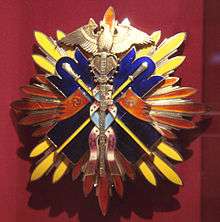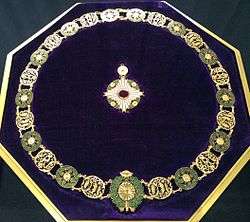Japanese honors system




Contains translated material from the corresponding Japanese Wikipedia article. Incomplete; may be expanded with translations from the corresponding Japanese Wikipedia article.
The Japanese honours system originated in the 1870s, shortly after the Meiji revolution, and was modeled on European honours system. The first order, the Imperial Order of Meiji was established in 1875, and was later renamed as the Order of the Rising Sun.[1]
Current Orders
- Supreme Order of the Chrysanthemum-Established in 1876 as the premier order of Japan; originally in one class (Grand Cordon) and expanded to two classes (Collar; Grand Cordon) in 1888.[2]
- Collar-The highest possible honour that may be conferred. The Collar is only worn by the reigning Emperor, and is normally only awarded to foreign monarchs as a courtesy. Before 1947, the Collar was also conferred upon extremely eminent Cabinet ministers, senior members of the Imperial family and certain senior military officers of the rank of Marshal. It may be posthumously awarded to extremely distinguished Prime Ministers of Japan; the last such award was to Eisaku Sato in 1975.
- Grand Cordon-Typically conferred upon royals of the Imperial House of Japan, foreign royalty who are not reigning monarchs, certain foreign non-royal Heads of State, and select Japanese Prime Ministers. Until 1947, the Grand Cordon was often conferred upon eminent military officers of the rank of Marshal. Often conferred posthumously. Yasuhiro Nakasone is the only living Prime Minister and Japanese subject to hold the Grand Cordon.
- Order of the Paulownia Flowers-Established in 1888 as a Special Grand Cordon to the Order of the Rising Sun, but made a separate order in 2003. Ordinarily the highest regularly awarded honor, it is conferred in a single class (Grand Cordon); typically awarded to Japanese prime ministers, senior statesmen, select foreign heads of government, distinguished cabinet ministers and jurists. Until 1947, it was also awarded to distinguished military officers of the rank of General or higher, or its equivalents.[3]
- Order of the Rising Sun-Established in 1875 as Japan's first order. Awarded in nine classes prior to 2003:[4]
- 1st Class: Grand Cordon
- 2nd Class: Gold and Silver Star
- 3rd Class: Gold Rays with Neck Ribbon
- 4th Class: Gold Rays with Rosette
- 5th Class: Gold and Silver Rays
- 6th Class: Silver Rays
The Grand Cordon of the order is typically awarded to foreign heads of government, chairpersons of prominent international organizations and leading politicians, business leaders and diplomats. Japanese Nobel Laureates were awarded the Grand Cordon of the Order. The second class is typically conferred upon prominent academics, politicians and military officers. The third through sixth classes are ordinarily conferred upon individuals who have made significant contributions to Japan or its culture in varying degrees. The 7th and 8th classes of the Order were abolished in 2003, and the Special First Class of the Order was renamed the Order of the Paulownia Flowers.
- Order of the Sacred Treasure-Established in 1888 as the Imperial Order of Meiji in eight classes. Awarded for long and meritorious service. The 7th and 8th classes were abolished in 2003.
- 1st Class: Grand Cordon
- 2nd Class: Gold and Silver Star
- 3rd Class: Gold Rays with Neck Ribbon
- 4th Class: Gold Rays with Rosette
- 5th Class: Gold and Silver Rays
- 6th Class: Silver Rays
The Order is typically awarded to middle-grade administrators and diplomats, prominent figures in international affairs, leading businessmen, senior provincial politicians, and scholars and artisans who have made contributions to Japan or have furthered its culture. Prominent academics and university administrators are often conferred with the order.
- Order of Culture-Established in 1937 as a single-class order of merit to honor those who have made outstanding contributions to Japanese culture.
- Order of the Precious Crown-Lowest ranking of the Japanese orders. Established in 1888 in five classes; expanded to seven classes in 1896. The 7th class of the order was abolished sometime after the Second World War. Initially awarded to select foreigners who were not eligible for a higher honor, but subsequently only awarded to women. From 2003, with the opening of the Order of the Rising Sun to Japanese women, the order has only been awarded to foreign females.
- 1st Class: Grand Cordon
- 2nd Class: Peony Class
- 3rd Class: Butterfly Class
- 4th Class: Wisteria Class
- 5th Class: Apricot Class
- 6th Class: Ripple Class
- Medals of Honor-Established in 1881 to honor individuals who have made distinguished achievements in their respective fields of society.
- Medal with Red Ribbon-to individuals who have risked their own lives to save others
- Medal with Green Ribbon-to morally remarkable individuals who have actively taken part in serving society
- Medal with Yellow Ribbon-to individuals who, through their diligence and perseverance, became public role models
- Medal with Purple Ribbon-to individuals who have contributed to academic and artistic developments, improvements and accomplishments
- Medal with Blue Ribbon-to individuals who have made prosperous efforts in the areas of public welfare and education
- Medal with Dark Blue Ribbon-to individuals who have made exceptionally generous financial contributions for the good of the public
Criteria for awards (Japanese nationals)
- Grand Cordon of the Order of the Chrysanthemum: The highest ordinarily conferred honor; for exceptional merit.
- Grand Cordon of the Order of the Paulownia Flowers: For an exemplary and distinguished level of merit.
- Grand Cordon of the Order of the Rising Sun: For highly distinguished national and/or public service.
- Grand Cordon of the Order of the Sacred Treasure: For long and distinguished national and/or public service.
- Second through Sixth Classes of the Order of the Rising Sun: For those cited for outstanding achievement.
- Second through Sixth Classes of the Order of the Sacred Treasure: For long and distinguished public service.
- Order of Culture: For particularly significant achievements in regards to the furthering of cultural development.[5]
Statistics
For the year 2015, 8050 decorations were conferred in the following numbers:
- Order of the Chrysanthemum
- Collar: 0
- Grand Cordon: 0
- Order of the Paulownia Flowers
- Grand Cordon: 1
- Order of the Rising Sun
- Grand Cordon: 17
- Gold and Silver Star (Second Class): 30
- Gold Rays with Neck Ribbon (Third Class): 68
- Gold Rays with Rosette (Fourth Class): 347
- Gold and Silver Rays (Fifth Class): 1133
- Silver Rays (Sixth Class): 227
- Order of the Sacred Treasure
- Grand Cordon: 1
- Gold and Silver Star (Second Class): 77
- Gold Rays with Neck Ribbon (Third Class): 554
- Gold Rays with Rosette (Fourth Class): 1365
- Gold and Silver Rays (Fifth Class): 1949
- Silver Rays (Sixth Class): 2281
- Gift Cup
- Silver: 0
- Wood: 0
References
- ↑ Summary of the Honors System
- ↑ Supreme Orders of the Chrysanthemum
- ↑ Grand Cordon of the Order of the Paulownia Flowers
- ↑ Orders of the Rising Sun
- ↑ "勲章の種類及び授与対象".
- ↑ Cabinet Office Decorations and Medals Bureau. "春秋叙勲受章者数(勲章別、年別、春秋別)(平成15年~)" (PDF). Retrieved 2016-03-12.
External links
- Japan, Cabinet Office: Decorations and Medals
- Japan Mint: Production Process

